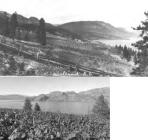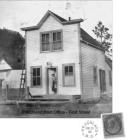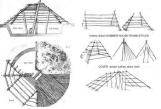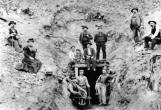2
OKANAGAN GEOLOGY10,000 years ago-Today
Peachland British Columbia
 Credits:
Credits:Peachland Historical Society
3
EARLY LOGGING & LUMBER PRODUCTION1902
Peachland British Columbia
 Credits:
Credits:Peachland Historical Society
4
PEACHLAND POST OFFICEDecember 1, 1898- Present
Peachland British Columbia
 Credits:
Credits:Peachland Historical Society
8
The first non natives to discover the site which later became Peachland were fur traders who ventured north from Fort Okanogan on the Columbia River in the early 1800's. These fur traders came with pack horses and travelled as far north as Fort Kamloops on the Thompson River. Loaded pack trains returned to Fort Okanogan and the furs were loaded on sailing ships which sailed to Europe.Gold was discovered in California in the 1840's and this caused a stampede of prospectors to search for the precious mineral throughout the mountains of western North America. These prospectors searched the Okanagan mountains and creeks and enjoyed the beautiful warm valley landscape surrounding Okanagan Lake.
About 1880 a few hardy settlers found arable land near the shores of Okanagan Lake and started to raise cattle and plant crops. The Canadian Pacific Railway completed its commitment to build a railway from the Atlantic Ocean to the Pacific Ocean across Canada in 1885. Okanagan settlers welcomed this railway because they could drive their mature cattle to Kamloops for loading onto trains to go to markets in eastern Canada. The CPR was pleased with the extra business and realised that the Okanagan was a potential increased revenue source. A branch line was extended south from Sicamous to Vernon on the Okanagan Lake and a steamship SS Aberdeen launched to supply residents along the shores of the Lake with regular service.
John Moore Robinson, one of the mining prospectors who came through Peachland, stopped at a log cabin beside Trepanier Creek, the first residence built in Peachland, and enjoyed some ripe peaches from a tree planted in the yard. John saw a future for fruit growing in the Okanagan Valley and returned to his Manitoba home where he convinced some of his investor friends to put up funds to purchase land in Peachland and sub-divide orchard lots. He named the area Peachland and soon settlers arrived and planted orchards. The community grew and sawmills were built to make lumber to build the homes for the newly arrived settlers. The Peachland Post Office opened for business on December 1st 1898 and a one room school opened the same year.
The community prospered and during the first two decades years of the new century a larger four room school was built in 1908, an octagonal Baptist Church in 1910, a Methodist Church in 1911, a Presbyterian Church in 1912 and an Anglican Church opened in the old one room school in 1908 Many orchards were planted and flourished
A cannery and packing houses were constructed on the shore and commerce increased with larger vessels, SS Okanagan and SS Sicamous, providing daily weekday service to Okanagan residents from Penticton to Vernon. On January 1st 1909 the young community became incorporated as the Corporation of the District of Peachland and was able to issue debentures to raise money to construct a dam and electricity generating facility on Trepanier Creek.
Our community had grown to 200 and a Regatta was held each year, starting in 1908, with Peachland's War Canoe teams successfully defending their wins until the Great War began in 1914. Our tiny community answered the Call to Arms and sent 33 young men off to war in Europe. When the war ended in 1918 only 18 returned and we had the sad honour of having the greatest per-capita loss of any Canadian town. To remember those who gave the greatest sacrifice a cenotaph was erected in 1921 and still is a respected reminder of human conflict. Additional names have been added to honour those who died in the Second World War and The Korean War.
After the Great War was over veterans returned to Peachland and worked in the orchards and sawmills as our community continued to grow. The great depression of the 1930's was severe in Peachland as orchards failed and prosperity seemed so far away. Work was scarce and most resident were forced to do some belt-tightening to survive. Slowly the economy recovered and Canada was cheered with a Royal Visit in 1939. However storm clouds were gathering over Europe and before the year was out Canada was once again at War with Germany.



